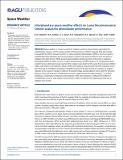Interplanetary space weather effects on Lunar Reconnaissance Orbiter avalanche photodiode performance.
Author(s)
Clements, E. B.; Carlton, A. K.; Joyce, C. J.; Schwadron, N. A.; Spence, H. E.; Sun, X.; Cahoy, K.; ... Show more Show less
Downloadswe20326.pdf (951.0Kb)
Metadata
Show full item recordAbstract
Space weather is a major concern for radiation-sensitive space systems, particularly for interplanetary missions, which operate outside of the protection of Earth's magnetic field. We examine and quantify the effects of space weather on silicon avalanche photodiodes (SiAPDs), which are used for interplanetary laser altimeters and communications systems and can be sensitive to even low levels of radiation (less than 50 cGy). While ground-based radiation testing has been performed on avalanche photodiode (APDs) for space missions, in-space measurements of SiAPD response to interplanetary space weather have not been previously reported. We compare noise data from the Lunar Reconnaissance Orbiter (LRO) Lunar Orbiter Laser Altimeter (LOLA) SiAPDs with radiation measurements from the onboard Cosmic Ray Telescope for the Effects of Radiation (CRaTER) instrument. We did not find any evidence to support radiation as the cause of changes in detector threshold voltage during radiation storms, both for transient detector noise and long-term average detector noise, suggesting that the approximately 1.3 cm thick shielding (a combination of titanium and beryllium) of the LOLA detectors is sufficient for SiAPDs on interplanetary missions with radiation environments similar to what the LRO experienced (559 cGy of radiation over 4 years).
Date issued
2016Department
Space Telecommunications Astronomy and Radiation (STAR) Lab; Massachusetts Institute of Technology. Department of Aeronautics and AstronauticsPublisher
Space Weather: The International Journal of Research & Applications
Citation
Clements, E. B., Carlton, A. K., Joyce, C. J., Schwadron, N. A., Spence, H. E., Sun, X., & Cahoy, K. (2016). Interplanetary space weather effects on Lunar Reconnaissance Orbiter avalanche photodiode performance. Space Weather: The International Journal Of Research & Applications, 14(5), 343. doi:10.1002/2016SW001381
ISSN
15394956